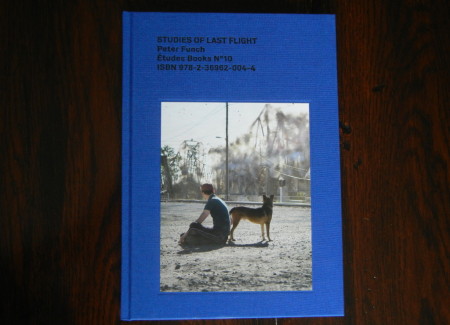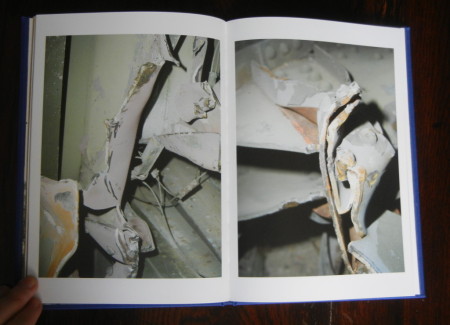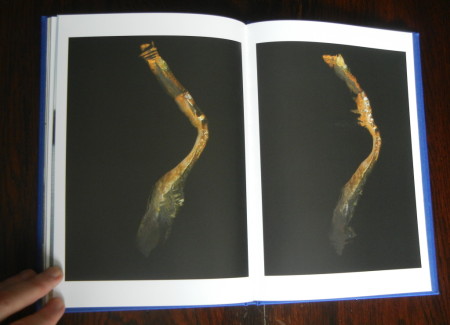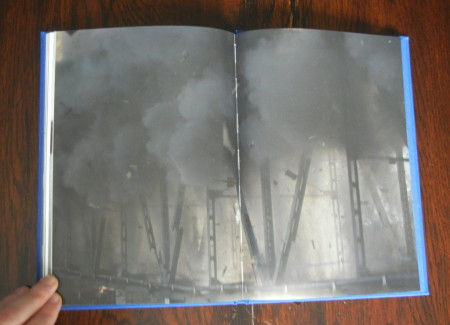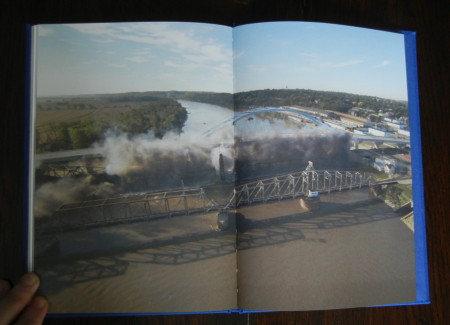JTF (just the facts): Published in 2014 by Études Books (here). Hardcover, 48 pages, with 28 color photographs. Includes a loose booklet with an essay by William Pym (in English and French). (Spread shots below.)
Comments/Context: Peter Funch’s Studies of Last Flight takes the simple idea of photographic simultaneity and extends it to its logical, and in this case surprisingly nuanced, extreme. Starting with the 2013 demolition of the Amelia Earhart Bridge in Atchison, Kansas (Earhart’s birthplace), as his central trigger, and with the help of students from a local photojournalism school, Funch has built out a layered portrait of a highly specific moment in place and time, seen from multiple vantage points. This book is just a sample of the much larger archive, but it effectively opens up the intriguing questions of what seeing with synchronicity might mean, and how such a complex perspective changes the way we construct collective narrative and memory.
Like the map of the jagged coastline that gets infinitely more detailed as we move in ever closer, Funch’s project deftly plays with visual scale, carefully telescoping in and out along one axis and then continually shifting to alternate perspectives. Aerial drones provide overview shots of the bridge imploding, giving us the broad framework context of the surrounding landscape and the muddy Missouri River. We then move in much closer, to images of the billowing smoke and flying debris that turn the sky black and smoky and envelop us in the chaotic energy release, effectively allowing us to see the explosion from all sides and inside.
If these images were the extent of Funch’s effort, we might have found ourselves in the familiar realm of Barbara Probst and her meticulously disorienting multi-camera pictures of still lifes and street corners. But Funch has taken those ideas in a different direction and expanded them by introducing a more multi-genre approach, going beyond the specific central action to more tangential and skew lines of thinking that bring in the fabric of the community. Several images capture townspeople watching the implosion, with an almost Jeff Wall-ish feeling of staged reality. A family picnics on a dock while fishermen watch from a nearby boat, a boy takes in the spectacle with his dog, and friends have set up lawn chairs to watch the show under a massive tree on the bank of the river like a 19th century Romantic painting. Each scene has the imploding bridge in the background, so each narrative is playing out in parallel but at exactly the same moment. It’s like they are all telling the story of what they were doing when the bridge was taken down, a momentous shared experience in the life of this small town.
Funch doesn’t stop there, but also adds in close-up still lifes of the mangled steel beams, seen both in flash lit glare soon after the event and later in the dissolving underwater gloom of a darkened studio set up. These images bring home the idea of change and transition (almost like flashbacks), the once proud structure reduced to tangled rubble to be carted away or left at the bottom of the river. They turn the specifics of the physical bridge into visual abstractions, the left over violence becoming squiggles of torn edges and heaps of bent wreckage, now mute exercises in line and form.
Seen together in mixed sequencing, Funch’s photographs feel like a rich, multi-dimensional portrait of this one event, one that we can take in from seemingly countless vantage points. The book builds narrative not from sequential step-by-step forward moving time (this happened and then that happened), but from layers of events taking place at the same instant, like a single point that expands to reveal stacks and matrices of hidden interwoven stories. There are conceptual echoes here of overlapped cinematic storytelling (like Robert Altman’s Short Cuts), but they have been reduced to a single frame photographic mode and then expanded to embrace several artistic styles. The power of the photobook form allows Funch to smartly push his simultaneous narrative somewhere new, where every turn of the page bends back on itself, until you find yourself at the end and the beginning.
Collector’s POV: Peter Funch is represented by V1 Gallery in Copenhagen (here); he does not appear to have gallery representation in New York at this time. His work has not yet reached the secondary markets, so gallery retail remains the best option for those collectors interested in following up.
